Everton Football Club
Everton were founded during November 1879 when the St. Domingo's Church held a meeting at the Queen's Head Hotel, Village Street. They already had a cricket team but wanted to find another sport for the winter month. The St. Domingo team played in Stanley Park and won their first game, against St Peter's Church, 6-0. The following year the club were renamed Everton F.C. after the surrounding area.
In 1880 Everton joined the Lancashire Football Association that had recently been established by John Lewis, the founder of Blackburn Rovers. Everton won the Liverpool Cup in 1884.
In 1884 John Houlding arranged for Everton to play on land he owned in Anfield. Stands were erected and attendance figures reached 8,000 per game.
On 2nd March, 1888, William McGregorcirculated a letter to Aston Villa, Blackburn Rovers, Bolton Wanderers, Preston North End, and West Bromwich Albion suggesting that "ten or twelve of the most prominent clubs in England combine to arrange home and away fixtures each season."
John J. Bentley of Bolton Wanderers and Tom Mitchell of Blackburn Rovers responded very positively to the suggestion. They suggested that other clubs should be invited to the meeting being held on 23rd March, 1888. This included Everton, Accrington, Burnley, Derby County, Notts County, Stoke, Wolverhampton Wanderers and Old Carthusians should be invited to the meeting.
The following month the Football League was formed. It consisted of six clubs from Lancashire (Everton, Preston North End, Accrington, Blackburn Rovers, Burnley and Bolton Wanderers) and six from the Midlands (Aston Villa, Derby County, Notts County, Stoke, West Bromwich Albion and Wolverhampton Wanderers). The main reason Sunderland was excluded was because the other clubs in the league objected to the costs of travelling to the North-East. McGregor also wanted to restrict the league to twelve clubs. Therefore, the applications of Sheffield Wednesday, Nottingham Forest, Darwen and Bootle were rejected.
The first season of the Football League began in September, 1888. Preston North End won the first championship without losing a single match and acquired the name the "invincibles". Everton finished in 8th place. They did much better the following season finishing in second, only two points behind Preston, who was once again champions.
In November 1888, during the first season of the Football League the Sporting Chronicle described how the Everton player, Alec Dick "struck another in the back in a piece of ruffianism". The victim of the assault, Albert Moore, the Notts County, inside-right, was not seriously injured. The newspaper went on to report: "One or two of the Everton team played very hard on their opponents, and hoots and groans were frequent during the match. When the teams left the field a rush was made for the Everton men, who had raised the ire of the spectators, and sticks were used. Dick was singled out, and was struck over the head with a heavy stick, the cowardly fellow was dealt the blow inflicting a severe wound on the side of the Everton man's head."
The Sporting Chronicle added: "Our own correspondent adds that Dick played anything but a gentlemanly game, while his language was coarse; but even these defects did not merit such cowardly and condign punishment as was administered at Trent Bridge". As a result of the incident Alec Dick was suspended by the Football League for the rest of the season.
Everton won the Football League championship in the 1890-91 season. The three main stars of the team were English internationals, Fred Geary, Edgar Chadwick and Alf Milward. Preston North End finished in second place. Geary was top scorer with 20 goals, followed by Milward (12) and Chadwick (10).
In 1891 John Houlding, the leaseholder of Anfield Stadium, purchased the ground outright and proposed increasing the rent from £100 to £250 per year. Everton, who had played at Anfield for seven years, refused to meet his demands and moved to Goodison Park. Houlding, now established a new club called Everton Athletic to play at Anfield. The Football Association refused to accept the name Everton Athletic and so it was changed to Liverpool Football Club.
In the 1891-92 season Everton strengthed the team by buying Bob Howarth and Jack Bell. However, they could only finish in 5th place to Sunderland, the new champions.
The following season Everton finished in 3rd place. They also had a good run in the FA Cup beating West Bromwich Albion (4-1), Nottingham Forest (4-2), Sheffield Wednesday (3-0), Preston North End (2-1) to reach the final against Wolverhampton Wanderers. Captained by Bob Howarth, and watched by 40,000 fans at the Fallowfield Ground, Everton lost the final 1-0.
Everton continued to do well in the First Division of the Football League finishing 2nd (1894-95), 3rd (1895-96), 7th (1896-97), 4th (1897-98) and 4th (1898-99). Everton also got to the 1897 FA Cup Final. A crowd of 60,000 arrived at Crystal Palace to watch the final against Aston Villa. Charlie Athersmith scored the opening goal but Everton hit back with goals from Jack Bell and Richard Boyle. Aston Villa continued to dominate the game and added two more from George Wheldon and Jimmy Crabtree. That finished the scoring and therefore Aston Villa had emulated the great Preston North End side that had achieved the FA Cup and Football League double in 1888-89 season.
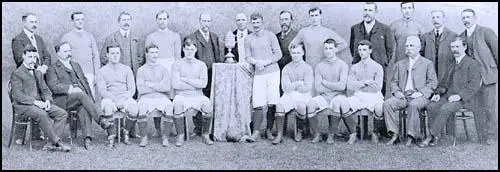
Walter Balmer signed for Everton and according to Tony Matthews, the author of Who's Who of Everton, he was "a thickset defender" with a "crunching tackle". He played for the club at both full-back positions. Everton was a very good side at the time finishing 2nd (1901-02), 3rd (1903-04) and 2nd (1904-05).
Everton had a good cup run in the 1905-1906 season beating Chesterfield Town (3-0), Bradford City (1-0), Sheffield Wednesday (4-3) and Liverpool (2-0). Everton beat Newcastle United 1-0 in the FA Cup Final played at Crystal Palace.
In April 1908 Everton signed Bert Freeman from Woolwich Arsenal. Tony Matthews argues in Arsenal Who's Who that this was "one of the great transfer blunders of those early years." In his first season with his new club he scored 38 goals which made him the league's top scorer. Freeman scored an amazing 61 goals in 86 games before being allowed to join Burnley in 1910.
Everton did not win the First Division championship again until the 1914-15 season. Unfortunately, the First World War brought an end to league football and this very good team was broken up.
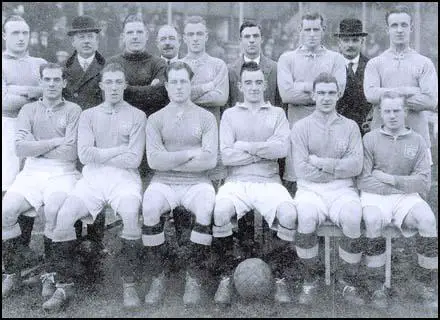
In March 1925 Dixie Dean joined Everton in the First Division for a transfer fee of £3,000. Dean was Everton's top scorer in his first full season with the club (1925-26). In Who's Who of Everton (2004) Tony Matthews described him as: "A football immortal, strong, dashing with a powerful right-foot shot and exceptional heading ability, Dixie Dean was, without doubt, one of the greatest centre-forwards of his era."
He suffered a serious motorcycle accident in Holywell in 1926, in which he suffered a fractured skull and jaw. He was told by doctors that he could not play football again. They were particularly concerned about the dangers posed by heading the ball.
Dixie Dean ignored that advice and was once again Everton's top scorer in the 1926-27 season. This included a large number of headed goals. In February 1927 Dean won his first international cap playing for England against Wales. Dean scored after 10 minutes and added a second before the end of the game. The following month he scored two more against Scotland. In May 1927, Dean scored hat-tricks against both Belgium and Luxembourg. In his first five games for England he scored an amazing twelve goals.
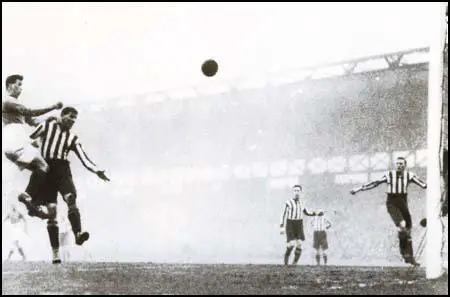
Dean was in sensational form in the 1927-28 season. He scored seven hat-tricks that season and ended up with a record-breaking 60 league goals in 39 games. Everton won the First Division title that season with 53 points, two more than their rivals Huddersfield Town.
Dixie Dean was also Everton's top scorer in the 1928-29 season. He repeated this feat in 1929-30 but could not save Everton from being relegated. Everton easily won the Second Division championship in the 1930-31 season. Dean scored in 12 consecutive league games and once again was the club's leading scorer.
Everton won the First Division championship in 1931-32. Dean scored eight hat-tricks that season and for the seventh successive season was Everton's top scorer. Dean also scored 28 FA Cup goals for Everton including one in the club's 3-0 victory over Manchester City in the 1933 FA Cup Final.
Joe Mercer made his debut for Everton in April 1933. The team at that time included Dixie Dean, Cliff Britton, Ted Sager, Albert Geldard, and Jack Jones.
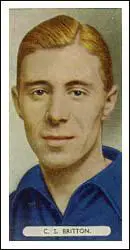
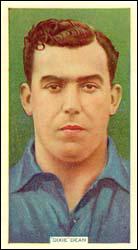
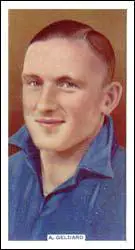
In December, 1936, Everton signed Tommy Lawton for a fee of £6,500. It was a record fee for a teenager. To encourage him to sign for the club, his grandfather was given a job as deputy groundsman at Goodison Park. One of the attractions of the deal was that Lawton now had the opportunity to play with Dixie Dean. When they met for the first-time, Dean put his arm round Lawton and said: "I know you've come here to take my place. Anything I can do to help you I will. I promise, anything at all." Dean was thirty years old and after suffering several serious injuries, he knew that there was not much time left for him at the top. Dean kept his promise and spent a lot of time with Lawton on the training field. Gordon Watson, who played at inside-left for Everton, later recalled: "Lawton and Dean used to work together under the main stand, Dean throwing up a large cased ball, stuffed with wet paper to make it as heavy as a medicine ball".
Six weeks after joining the club, Tommy Lawton was brought into the first team for an away match against Wolverhampton Wanderers, as Dixie Dean was rested prior to a fifth round FA Cup tie with Tottenham Hotspur. Lawton found it difficult playing against the England centre-half, Stan Cullis, however, he did score a goal 15 minutes from the end.
Everton drew the FA Cup tie with Tottenham Hotspur 1-1 and it was decided to play Tommy Lawton alongside Dixie Dean in the replay. In the second minute Lawton scored with a tremendous shot from outside the penalty area. Dean turned to Joe Mercer and said: "Well, that's it then. That's the swan song. That's the end of it." Dean realised that it would not be long before this talented player took his place in the side.
After twenty minutes Albert Geldard provided the centre for Dean to put 2-0 up. Dean later added a third but Tottenham Hotspur scored four to go through to the next round.
In the next game Everton beat Leeds United 7-0 with Dean and Lawton both scoring good goals. At the end of the 1936-37 season Dean had scored 24 goals in his 36 league games whereas Lawton had three in ten.
John Jones, Everton's young full-back, later argued that it was Dixie Dean who was the main coach at the club: "Dixie was the boss. Young players at Everton had to keep in order otherwise they were pretty soon stepped on... It was Dixie, along with a couple of England centre-halves, Charlie Gee and Tommy White who ran the show. Occasionally they'd call a meeting and they'd be telling the youngsters what to do. It was the best method of coaching I ever experienced." Lawton agreed but claimed that: "All they ever said was make sure you pass it to a man in the same shirt."
At the beginning of the 1937-38 season Tommy Lawton played at inside-right and Dixie Dean at centre-forward. The pairing did not work and Everton failed to win a game when they two men played together. On 8th September 1937, Dean was dropped and Lawton replaced him as centre-forward to play against Manchester City. Lawton scored in the 4-1 victory and Dean only played in two more games for Everton before leaving the club.
Tommy Lawton became the youngest player, 17 years, 362 days, to score in a Merseyside derby when Everton played at Anfield on 2nd October 1937. Liverpool lost 2-1. It was their first win at Anfield since 1931. Lawton also scored against Leeds United, which made it 5 in 8 matches and Everton began to climb the table. On the Monday after the Leeds game Lawton upset the senior players by walking into the dressing room and saying "morning boys". As a result Lawton was thrown fully-clothed into the bath.
Everton finished in 14th place in the 1937-38 season with Lawton ending up as the club's top marksman with 28 goals in 39 league games. He was also the top scorer in the whole of the First Division. This was an amazing achievement for someone who was only 18 years old.
After scoring 38 goals in 180 games for Everton Albert Geldard was transferred to Bolton Wanderers for £4,500 in July 1938. Tommy Lawton was very upset by the decision to sell Geldard: "He was the fastest thing on two legs over ten yards. We had other wingers like Torry Gillick, Wally Boyes and Jimmy Caskie, but Albert had played for England only the season before, when he'd kept Stan Matthews out of the team. I thought we'd miss him."
Everton won the first four games of the 1938-39 season. The fifth game was against Arsenal, the current league champions, at Highbury. After 15 minutes Tommy Lawton passed to Alex Stevenson, who scored from close range. Lawton got the second in the 38th minute. George Casey of the Sunday Pictorial described it as "another wonder goal" from Lawton.
In the second-half, Bryn Jones, scored for Arsenal from 30 yards. However, Everton held on to their lead although Lawton suffered a battering from Wilf Copping. Lawton constantly beat the Arsenal defenders in the air and Copping warned him that he was "jumping too high" and that he would have to be "brought down to my level". As Lawton later recalled: "Sure enough the next time we both went for a cross, I end up on the ground with blood streaming from my nose. Wilf was looking down at me and he said 'Ah told thee, Tom. Tha's jumping too high!' My nose was broken. When Arsenal came to Everton, Copping broke my nose again! He was hard, Wilf. You always had something to remember him by when you played against him."
Charlie Buchan in the Daily Chronicle argued that Tommy Lawton was the main reason for Everton's 2-1 victory: "Lawton had a lot to do with the success. He beat Joy for the ball in the air, kept the wings moving and was ever dangerous in front of goal."
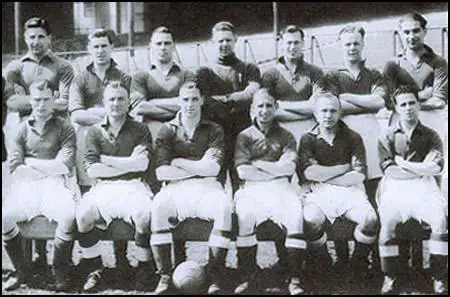
Ted Sager, Joe Mercer, Norman Greenhalgh, John Jones. Front row: Torry Gillick,
Stan Bentham, Tommy Lawton, Alex Stevenson, Wally Boyes and Jimmy Caskie.
That season Everton won the First Division league title, by beating Wolverhampton Wanderers by four points. Tommy Lawton was the club's top marksmen with 34 goals in 38 games. For the second season in a row Lawton was the top scorer in the First Division.
Primary Sources
(1) Philip Gibbons, Association Football in Victorian England (2001)
Everton greatly improved following the arrival of Jack McGill and Dan Doyle from north of the border, which resulted in them winning the Liverpool Cup during the 1883-84 season. Upon moving to an enclosed ground in Priory Road in the Anfield district of Liverpool, the owner, a Mr Cruitt, decided to evict the club, owing to its often excitable supporters, which saw them move to a field in Anfield Road. While Everton enjoyed continued success on the field, John Houlding, a former president of the club and later Lord Mayor of Liverpool, felt that the ground rent should be raised in view of their success. However, the Everton committee totally rejected the suggestion. A further move resulted, to a ground in Goodison Road. Mr Floulding made every effort to retain the name of Everton, but with the majority of their players moving to the new ground, he was forced to change the name to Liverpool Football Club. Liverpool, like Everton, enjoyed much success during the final decade of the century.
(2) The Sporting Chronicle (19th November, 1888)
In the progress of the game Dick of Everton, struck A. E. Moore in the back, a piece of ruffianism which produced a lively verbal encounter. One or two of the Everton team played very hard on their opponents, and hoots and groans were frequent during the match. When the teams left the field a rush was made for the Everton men, who had raised the ire of the spectators, and sticks were used. Dick was singled out, and was struck over the head with a heavy stick, the cowardly fellow was dealt the blow inflicting a severe wound on the side of the Everton man's head. The footballers got separated in the excited crowd, but sturdy Holland and Frank Sugg forced their way to the rescue, and Sugg succeeded in gripping the man who struck Dick. He, however, escaped, though constables arrived quickly. Sugg, Holland, and one or two others protected Dick to the pavilion, where his injuries were attended to. This drastic aspect of football is new to Nottingham, and it is a great pity the perpetrators of this cowardly outrage were not secured and handed over to the police. This we are sure will be the feeling of all respectable people who have the interests of football, of the Notts club, and of the reputation of the town at heart.
Our own correspondent adds that Dick played anything but a gentlemanly game, while his language was coarse; but even these defects did not merit such cowardly and condign punishment as was administered at Trent Bridge by Nottingham "lambs" under mob law.
(3) Tony Matthews, Who's Who of Everton (2004)
A football immortal, strong, dashing with a powerful right-foot shot and exceptional heading ability, Dixie Dean was, without doubt, one of the greatest centre-forwards of his era.
(4) Nick Walsh, Dixie Dean: The Official Biography of a Goalscoring Legend (1977)
The reason (why he disliked being called Dixie) was that at the time he felt "Dixie" had connections with colour problems connected with the Southern states of America, and therefore contained an inference that he was of that origin, or half-caste.
